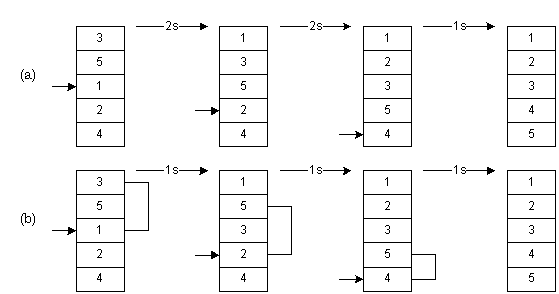In Figure 2-2(b) an example of shell sort is illustrated. We begin by doing an insertion sort using a spacing of two. In the first frame we examine numbers 3-1. Extracting 1, we shift 3 down one slot for a shift count of 1. Next we examine numbers 5-2. We extract 2, shift 5 down, and then insert 2. After sorting with a spacing of two, a final pass is made with a spacing of one. This is simply the traditional insertion sort. The total shift count using shell sort is 1+1+1 = 3. By using an initial spacing larger than one, we were able to quickly shift values to their proper destination.

Various spacings may be used to implement a shell sort. Typically the array is sorted with a large spacing, the spacing reduced, and the array sorted again. On the final sort, spacing is one. Although the shell sort is easy to comprehend, formal analysis is difficult. In particular, optimal spacing values elude theoreticians. Knuth has experimented with several values and recommends that spacing h for an array of size N be based on the following formula:
Thus, values of h are computed as follows:
h1 = 1To sort 100 items we first find an hs such that hs >= 100. For 100 items, h5 is selected. Our final value (ht) is two steps lower, or h3. Therefore our sequence of h values will be 13-4-1. Once the initial h value has been determined, subsequent values may be calculated using the formula
h2 = (3 x 1) + 1 = 4
h3 = (3 x 4) + 1 = 13
h4 = (3 x 13) + 1 = 40
h5 = (3 x 40) + 1 = 121